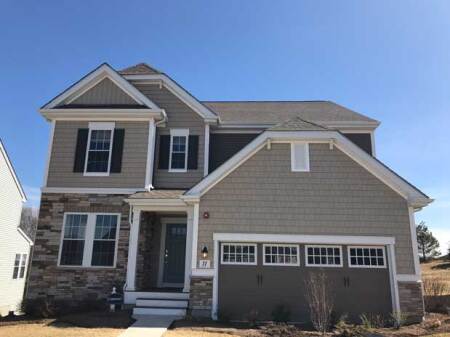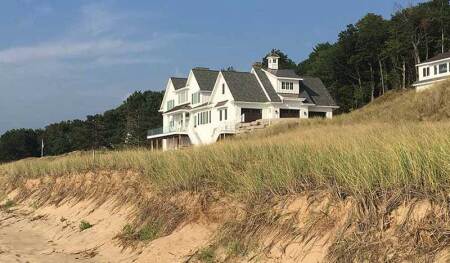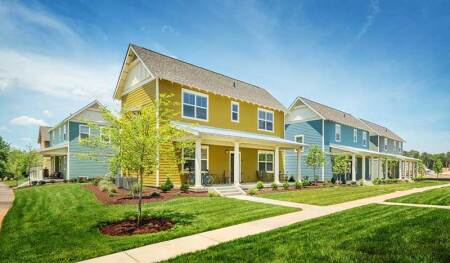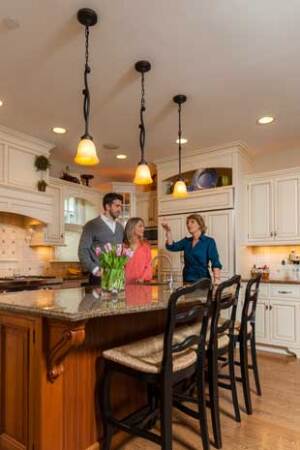This article was prepared by the nonprofit Home Fire Sprinkler Coalition (HFSC), a national 501(c)(3) educational organization. HFSC creates and offers neutral and informative material at no cost, primarily focused on new single- and two-family development projects in the U.S. and Canada.
Home Fire Sprinkler Incentives and Economic Performance
In many municipalities today, savvy developers are tapping into local incentive programs offered by authorities having jurisdiction (AHJs). Fire sprinkler incentives (sometimes called trade-ups) can generate lower costs and bigger profits when fire sprinklers are installed in one- and two-family home developments. While providing life- and property-safety, incentives also allow building and fire code officials the flexibility to accept alternative solutions to regulatory challenges. While many of these incentives can result in cost savings for the developer, they are ultimately a win-win for the homebuyer, first responders, and the entire community.
In jurisdictions that do not have codes or ordinances that require fire sprinklers in new-home construction, the AHJ has the ability to offer developers valuable incentives in exchange for installing fire sprinklers. These incentives vary, but include allowing development in areas that cannot otherwise be developed due to terrain or environmental constraints or permitting higher density, or reduce infrastructure and other construction costs. It is important that all stakeholders agree on what incentives are appropriate during the pre-development planning stage.
This three-minute video provides a summary of common developer incentives and a testimonial where a developer saved $1 million in material costs by eliminating an entrance road.
Legacy Farms and The Trails in Hopkinton, Massachussetts (pictured)
In the late 1990s, a company requested to sell a large parcel of agricultural land to new-home developers in Hopkinton, Massachussetts. The Town responded with a comprehensive agreement to permit construction of approximately 1,000 new homes with conditions to protect the area’s open spaces, control school growth, and ensure fire protection. Fire sprinklers in every new home allowed the town to offer frontage compromises and closer proximity to other buildings. Today, more than half of the property is completed with fire sprinklers installed at just over $1.15 per sprinklered square foot. Fire officials have already documented two fire sprinkler success stories in the development – one a cooking fire and the other a fire caused by an unattended candle. Thanks to the sprinklers, no injuries occurred in either case.
While every jurisdiction has its own concerns, zoning needs and other requirements, typical home fire sprinkler incentives include cost savings such as:
Additional Units Permitted—Development plans may allow homes to be built closer together.
Street Main Pipe Sizing May Be Minimized - public water flow requirements for the development can simply be based on the domestic demand as the additional full fire flow demand required for unsprinklered developments will no longer be necessary.
Increased Hydrant Spacing—Supply mains may be reduced and hydrant spacing can be increased.
Street-Width Reduction—Traffic lanes may be narrowed, substantially reducing the amount of pavement in every linear foot of street in the development.
Longer Dead-End Streets—Dead-end streets may be increased in length, allowing additional building lots to be accessed.
Tee Turnarounds Permitted—The permitted use of tee turnarounds in sprinklered developments can create at least one additional lot per cul-de-sac.
Increased Street Grades and Building Setbacks—Steeper street grades and building locations may be allowed further from where the homes’ access leaves the main road.
Subdivision Single Access Point—A fully sprinklered subdivision allows for a single public access road. This decreases infrastructure costs and significantly increases the number of single-family dwellings allowed.
Gated Communities—Gated communities can delay fire department access. A fully sprinklered subdivision provides mitigation for this impact allowing developers to utilize this security option when desired – often a marketing advantage.
Reduced Basement Windows—Fire sprinklers reduce required rescue openings in every basement sleeping room.
Home Fire Sprinklers Support Responsible Land Use
When a development is under consideration in an environmentally-sensitive area, there are many potential pitfalls. This is where good participation across disciplines truly pays off. Pre-development planning meetings unearth the challenges that can derail an otherwise profitable project. The AHJ has the power to work with developers and planners at this stage to identify creative and mutually beneficial options for community success. Installing fire sprinklers is one very effective tactic that can positively impact the outcome.
Dunegrass in Saugatuck, Michigan
In Saugatuck, Michigan, a proposed 21-unit development was located in environmentally protected dunes on the shore of Lake Michigan, prohibiting project approval. The critical dunes would have been damaged if the developer used full-width streets, as required for an unprotected development, and the State DEQ was poised to deny approval. In addition, the development is located several miles from the closest fire station and has very limited water availability for suppression efforts. In exchange for installed fire sprinklers in all houses and attached garages, the AHJ permitted narrower streets, avoiding impact on the dune areas.
Sustainable Housing
Climate change concerns affect virtually every community. One of the reasons AHJs are keen on offering incentives in exchange for fire sprinklers is that the technology is green.
HFSC partnered with FM Global, one of the world’s largest commercial property insurers, on an unprecedented research project to identify, analyze, and evaluate the environmental impact caused by home fires. Full-scale fire tests proved the environmental value of sprinklered home fires. Compared to home fires without sprinklers:
- Greenhouse gas emissions were cut by 97.8 percent
- Water usage was reduced by at least 50 percent
- Fewer persistent pollutants, such as heavy metals, were found in sprinkler wastewater versus fire hose water.
Responsible water use is a vital goal today, and most community plans emphasize and reward development strategies that make this a priority. Watch a brief video clip on fire sprinkler water usage in the City of Scottsdale, Arizona.
Scottsdale is a national model for home fire sprinkler success. A local ordinance in 1986 required fire sprinklers in all new homes. Today, more than half the city’s housing stock is protected. But fire safety is only part of the story. In a 2016 article in NFPA Journal, former Scottsdale Fire Marshal Jim Ford explained: “There was an initial study done on fire hydrants and water flow requirements, and our water department found that with hydrant spacing and our infrastructure, it would save in the neighborhood of $7 million to $8 million if we required all buildings to be sprinklered. That’s a huge savings for the community. Also, because of the reduced fire problem, the fire department can do a lot more for the community. We fully embrace the all-hazards approach to response and community risk reduction. We do hazmat. We do community outreach. We do emergency medical services, which is anywhere from 60–80 percent of our calls now. We’re providing a much better level of service on the type of calls that regularly impact our community.”
Water supply requirements for one- and two-family homes are much simpler than the water supply requirements for sprinkler systems in industrial and commercial buildings, or even when compared to larger multi-unit residential buildings. Learn about the distinctions in water connections, supply, and flow in home fires.
Healthier Communities
Why are home fire sprinklers desirable? Eight of 10 structure fire deaths occur where people tend to feel safest – at home. Today, a house fire can become deadly in as little as two minutes. Our furniture and belongings are made of plastics and synthetics that make fires burn faster and emit deadly smoke. Common unprotected lightweight building materials, flooring, and open designs can cause fires to spread quickly. Unprotected house fires are deadly for residents as well as for responding firefighters.
Watch a video comparison of a house fire without fire sprinklers and with fire sprinklers.
Installed fire sprinklers make homes far safer. That benefits the community overall, making it stronger and better.
Increasingly, home fire sprinklers are part of the nation’s growing emphasis on community risk reduction (CRR). CRR is a public safety strategy whereby community officials use scientific means to identify risks and then prioritize available resources before investing them. CRR contributes to the wellbeing of the whole community.
Homestead at Hartness, Greenville, South Carolina
In Greenville, South Carolina, a planned project was not able to meet requirements, and, if built as-is, would have resulted in far less density than developers conceived. In exchange for installing fire sprinklers in every home to meet life safety provisions, Fire Marshal Jeff Nelson offered the developer the opportunity to build the neighborhood as planned. This resulted in a net gain of 28 homes for the developer and greater safety for the entire community. “With fire sprinklers in every home, we only need to commit one engine to the dead-end road of a fire call because the sprinklers are attacking the fire before we get there,” says Fire Marshal Nelson. “It’s like having a firefighter on duty in each home! If we look at the big picture, there are opportunities to provide cost-saving incentives that meet the needs of the developers and provide critical life saving features in newly constructed homes, building success stories one home at a time.”
Marketability
Developments with fire sprinklers offer prospective homebuyers a better product than the competition. What could be more valuable than selling a house with peace of mind?
Watch a short video about marketing homes with installed fire sprinklers.
In a national Harris Poll survey conducted on behalf of the nonprofit Home Fire Sprinkler Coalition (HFSC), 74 percent of U.S. homeowners said they would be more likely to buy a home with fire sprinklers than one without. Seven in 10 said a sprinklered house has more value.








